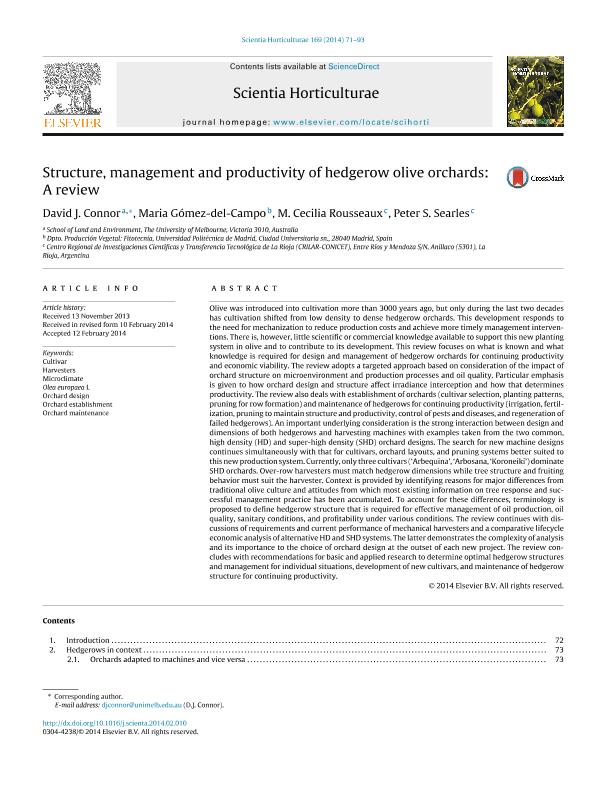Artículo
Structure, Management and Productivity of Hedgerow Olive Orchards: A Review
Fecha de publicación:
04/2014
Editorial:
Elsevier Science
Revista:
Scientia Horticulturae
ISSN:
0304-4238
Idioma:
Inglés
Tipo de recurso:
Artículo publicado
Clasificación temática:
Resumen
Olive was introduced into cultivation more than 3000 years ago, but only during the last two decades has cultivation shifted from low density to dense hedgerow orchards. This development responds to the need for mechanization to reduce production costs and achieve more timely management interventions. There is, however, little scientific or commercial knowledge available to support this new planting system in olive and to contribute to its development. This review focuses on what is known and what knowledge is required for design and management of hedgerow orchards for continuing productivity and economic viability. The review adopts a targeted approach based on consideration of the impact of orchard structure on microenvironment and production processes and oil quality. Particular emphasis is given to how orchard design and structure affect irradiance interception and how that determines productivity. The review also deals with establishment of orchards (cultivar selection, planting patterns, pruning for row formation) and maintenance of hedgerows for continuing productivity (irrigation, fertilization, pruning to maintain structure and productivity, control of pests and diseases, and regeneration of failed hedgerows). An important underlying consideration is the strong interaction between design and dimensions of both hedgerows and harvesting machines with examples taken from the two common, high density (HD) and super-high density (SHD) orchard designs. The search for new machine designs continues simultaneously with that for cultivars, orchard layouts, and pruning systems better suited to this new production system. Currently, only three cultivars (‘Arbequina’, ‘Arbosana, ‘Koroneiki’) dominate SHD orchards. Over-row harvesters must match hedgerow dimensions while tree structure and fruiting behavior must suit the harvester. Context is provided by identifying reasons for major differences from traditional olive culture and attitudes from which most existing information on tree response and successful management practice has been accumulated. To account for these differences, terminology is proposed to define hedgerow structure that is required for effective management of oil production, oil quality, sanitary conditions, and profitability under various conditions. The review continues with discussions of requirements and current performance of mechanical harvesters and a comparative lifecycle economic analysis of alternative HD and SHD systems. The latter demonstrates the complexity of analysis and its importance to the choice of orchard design at the outset of each new project. The review concludes with recommendations for basic and applied research to determine optimal hedgerow structures and management for individual situations, development of new cultivars, and maintenance of hedgerow structure for continuing productivity.
Archivos asociados
Licencia
Identificadores
Colecciones
Articulos(CRILAR)
Articulos de CENTRO REGIONAL DE INV. CIENTIFICAS Y TRANSFERENCIA TECNOLOGICA DE ANILLACO
Articulos de CENTRO REGIONAL DE INV. CIENTIFICAS Y TRANSFERENCIA TECNOLOGICA DE ANILLACO
Citación
Connor, David J.; Gómez del Campo, Maria; Rousseaux, Maria Cecilia; Searles, Peter Stoughton; Structure, Management and Productivity of Hedgerow Olive Orchards: A Review; Elsevier Science; Scientia Horticulturae; 169; 4-2014; 71-93
Compartir
Altmétricas




